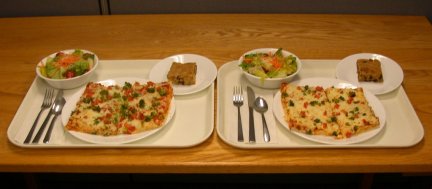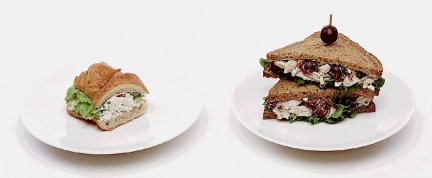Fooling the Satiety Meter (with recipe)
Want to lose weight without counting calories? A new study finds that the easiest strategy might be reducing a meal’s energy density—calories per ounce of food. When volunteers were offered such density-diminished meals, they rated the fare as filling—and as palatable—as they had full-calorie versions of the same foods.



Smaller portions also curbed how much someone chose to eat, the new Pennsylvania State University study found—but only about half as effectively as cutting the food’s energy density did. Doing both sated a diner’s hunger better still.
Neither tactic is novel. Indeed, the two-part approach of cutting portion size and reducing energy density underlies a series of books authored by Penn State’s Barbara Rolls. She terms the approach “volumetrics.”
Until her latest study, however, which appears in the January American Journal of Clinical Nutrition, no one had evaluated the separate and combined effects of the two strategies for more than one meal at a time, Rolls says. Her new trial employed each tactic for all meals eaten over a 2-day stretch to evaluate whether the body compensates for unwittingly eating less—or more—than usual. The new study found that the body doesn’t defeat the diet strategy.
The trial employed many commonly eaten, commercially available offerings, such as pizza, chips, and muffins. Previous experiments had tended to focus on casseroles, Rolls notes, in which it’s easier to mask tinkering with a recipe’s fat, carbohydrate, and protein loads.
Finally, the nutrition scientist notes, this study for the first time demonstrates how substantially more effective adjusting energy density is—compared with reducing portion size—in getting the body to think it’s eaten all it needs.
She says her team’s latest findings suggest that food manufacturers can become better at helping people moderate their calorie intake—by making changes in food that draw little attention from our taste buds.
Dietary deception
The body has evolved a series of sensors to prompt us to acquire enough energy to thrive. Several hormones and other chemical agents indicate, by making us hungry, when it’s time to eat (SN: 4/2/05, p. 216). Related hormones and systems signal satiety—the signal that it’s time to move away from the dinner table (SN: 8/10/02, p. 83: Available to subscribers at Fullness Factor: Gut hormone tells brain the stomach is well fed).
Ample research has shown, however, that this system of checks and balances is imperfect at best: Indeed, that’s one reason why—in this age of abundant, low-cost food—obesity has become rampant.
Rolls’ team is among several that have been probing the cues offered by food—and its presentation—that sabotage the hunger-satiety system.
One of the group’s early attempts to manipulate the energy density of food showed that adding water—essentially converting a casserole to a soup—reduced the number of calories that people consumed during a meal. Drinking a glass of water with the casserole didn’t produce the same effect. Such data indicated, Rolls concluded, that food and drink affect hunger and satiety “through entirely different mechanisms” and that when the water is part of an entree, as in soup, it’s no longer a drink but a food (SN: 4/24/99, p. 261).
Her team has also shown that when foods are offered in smaller portions, people tend to voluntarily limit their overall consumption of those items.
The “Super Bowl” effect
Brian Wansink of Cornell University has also been exploring the concept of portion control. In one of a series of clever experiments, his team showed that people who unknowingly ate from self-refilling bowls consumed almost 75 percent more tomato soup that did people eating from normal bowls. However, people eating from the refilling bowl didn’t realize they had downed more than a bowlful, a questionnaire showed, nor did they feel any more sated than were the people eating from a normal soup bowl.
“In lieu of monitoring how much one is eating, people [usually] rely on visual cues or rules-of-thumb (such as eating until a bowl is empty) to determine how much to consume,” the researchers concluded.
Wansink and Matthew M. Cheney at the University of Illinois found that even when people were serving themselves, the size of the serving bowl could covertly influence consumption. They demonstrated this among 40 graduate students invited to a Super Bowl party.
Upon arriving, each guest was invited to take some snacks from a buffet table. There were two such tables, one on either side of the room. As guests arrived, they were alternately directed to one table or the other.
Although the high-energy snacks on each table—assorted nuts and a pretzel-chip variety mix—were identical, the serving bowls that held those snacks weren’t. On one table, snacks were available from 4-liter bowls, twice the size of bowls on the other table.
After each guest used a 1-cup scoop to place as much food as he or she wanted onto a 10-inch plate, one of the hosts weighed the plate and then directed the guest to a table to watch the game. After the last snacker filled his or her plate, the buffet tables were cleared.
As the guests watched the game, they ate—but were offered no drinks.
In the April 13, 2005 Journal of the American Medical Association, Wansink and Cheney reported that people served themselves 53 percent more food from the big bowls than from the smaller ones—and ate 56 percent more food than did people who had gone to the smaller-bowl buffet table. The average difference in intake: 142 calories per person.
“Larger bowls, like larger packages or portions, may suggest that a proportionately larger amount is appropriate to consume,” the researchers speculated. One way to use this “portion distortion” to advantage, they concluded, is to put healthy foods—ones you want people to consume, such as fruits or vegetables—in larger serving bowls.
Effects are lasting
In the latest Penn State trial, 24 young women received all of their meals and snacks from the researchers for 2 consecutive days, on four separate occasions. Each 2-day cycle was spaced at least 2 weeks apart and served the same menu. Only portion sizes and energy density of individual items varied.
In one cycle, all foods were served in typical portion sizes and contained a relatively high energy density. Another time, foods arrived in small portions and had reduced energy density. During the remaining cycles, normal-energy meals were doled out in small portions or low-energy-density foods were served in large portions.
At each meal, a tray of food contained more than most women could easily consume. Each participant was invited to down all she wanted within the privacy of an individual cubicle. By subtracting the calorie value of foods left on a tray at the end of a meal, the researchers could compute the diner’s calorie consumption.
All foods came in high-energy- and low-energy-density versions, depending, for instance, on how much fat or sugar had been included in the recipe. Breakfasts consisted of muffins with yogurt or coffee cake with canned peaches. One lunch contained pizza, salad, and dessert; the other offered turkey sandwiches, chips, and brownies. Dinners were casseroles with chips and ice cream or pasta with green beans, garlic bread, and pie. Evening snacks of cheese and crackers, grapes, or raisins rounded out each day.
On days when the portion sizes were 25 percent smaller than usual, the women tended to eat 10 percent fewer calories than on the days they got regular foods in normal portions. But when the energy density was dropped by 25 percent, participants cut their energy intake by 24 percent—some 575 calories per day. Cutting portion size and energy density prompted the women to spontaneously drop their intake even more—by some 33 percent, or more than 800 calories per day.
Heavy women were just as likely to cut their intake as were slim ones. In other words, Rolls told Science News Online, “it appears that these food-related cues are pretty widespread and that everybody is susceptible to them.” In fact, she notes, most of the healthy-weight volunteers unwittingly failed to eat enough food to maintain their weight during those cycles in which the energy density of the foods had been reduced.
“Most astounding,” she found, was that tinkering with portion size or energy density led to the same proportional cutback in intake at every meal over a 2-day cycle. It didn’t occur just during the first meal or two, after which a woman might have subconsciously compensated for reduced calories by eating more.
Lessons for healthier dining
Health-conscious diners and cooks can derive helpful tips from the new data, Rolls says.
For example, when eating out, people might ask a waiter to wrap up part of the meal before it’s served, because “once it’s in front of you, you’re going to eat it,” says Rolls. Or, consider sharing entrees with others at the table, rather than ordering what the restaurant considers a full portion. Because many of today’s restaurants serve substantially bigger—and more caloric—portions of food than they did a decade ago (see Dietary Inflation), Rolls says it’s easy to overeat. “I think my record is five meals that I’ve gotten from the leftovers that I brought home [from a restaurant].”
Indeed, with such observations in mind, the National Restaurant Association has developed a list of tips for eating healthily when away from home (see Home Cooking on the Wane). Among them: Ask for salad dressings and sauces on the side, choose entrees with fruits and vegetables as major ingredients, and make a meal of two appetizers or an appetizer and a salad.
At home, Rolls says, cooks should consider cutting back on the amount of margarines, cheeses, and other energy-dense ingredients that they use in cooking and baking. She also recommends diluting meats in casseroles with hefty portions of vegetables and fiber, such as whole grains. When it’s time to serve up the food, Rolls recommends that cooks apportion servings onto plates before they reach the table. Placing bowls of food in easy reach on the dinner table tempts people to dish out unnecessary second helpings.
Finally, she recommends that people “pay attention” to their food. “It’s easy to overeat when you’re not paying attention,” she says, so diners should limit distractions, such as watching television or reading. And throughout the meal, keep asking yourself, “Am I still hungry?” As soon as the answer is no, she says, it’s time to stop eating.
RECIPE:
Almond Chicken Salad Sandwich
Ingredients:
- 1.5 cups diced, cooked chicken breast
- 1 tbs toasted slivered almonds
- 1 cup halved, seedless red grapes
- 1/2 tsp ground black pepper
- 1/4 cup diced celery
- 8 thin slices multigrain bread
- 1/4 cup reduced-fat mayonnaise
- 2 cups shredded leaf lettuce
Directions:
Combine chicken, grapes, celery, mayonnaise, almonds, and pepper in a medium bowl and mix well.
Divide this mix evenly onto four slices of bread. Top each with a 1/2 cup lettuce and another slice of bread.
Yield: 4 servings, 275 calories each. Omit the bread: 150 calories/serving.
From The Volumetrics Eating Plan (2005, Barbara Rolls, HarperCollins)







